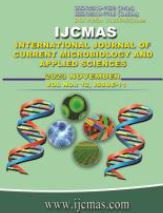


 National Academy of Agricultural Sciences (NAAS)
National Academy of Agricultural Sciences (NAAS)

|
PRINT ISSN : 2319-7692
Online ISSN : 2319-7706 Issues : 12 per year Publisher : Excellent Publishers Email : editorijcmas@gmail.com / submit@ijcmas.com Editor-in-chief: Dr.M.Prakash Index Copernicus ICV 2018: 95.39 NAAS RATING 2020: 5.38 |
Staphylococcus epidermidis is the most common normal flora of human skin. There is a delicate balance between skin barrier and innate immunity to maintain healthy skin and disturbance of the balance can predispose the host to a number of cutaneous and systemic infections. Aim-The present study is intended to find out the frequency of Staphylococcus epidermidis (S. epidermidis) of the patient normal flora causing skin infections by comparing the antibiotic sensitivity pattern of the strains isolated from clinically proven cases and strains from the healthy skin sites of the same patient. Methodology-Two types of S. epidermidis strains were collected, fifty strains isolated from clinically and microbiologically proven skin infections and fifty S. epidermidis strains isolated from the healthy skin of the same patient. Strains were stored in nutrient agar slopes at 40 C. Antibiotic sensitivity of these two groups of strains were performed on Mueller Hinton agar by standard Kirby-Bauer method and the antibiogram was compared to find out the frequency at which same strains of patient’s skin flora is isolated from active skin infections. Result- The strains of S. epidermidis from lesions exhibited high resistance against penicillin 87%, ampicillin 64%, erythromycin 64%, clindamycin 60% and ciprofloxacin 52% respectively. Linezolid and amoxiclav were the two antibiotics to which maximum strains of S. epidermidis from lesion was sensitive, 92% each. Increased resistance rate 60% was observed against clindamycin. Statistically significant (p-value < 0.05) difference in antibiogram of two groups S. epidermidis indicate that S. epidermidis strains of patient may not always cause wound infection, instead either the strains acquired extra virulence among the skin flora or strains acquired from external source establishes wound infection. Methicillin resistance was 8% among strains from lesion compared to zero percent among skin flora strains. Conclusion-It is observed that majority of the S. epidermidis strains isolated from skin infection exhibited higher rate of drug resistance compared to the strains isolated from the healthy skin of the same patient.-So it can be concluded that majority of wound infection caused by S. epidermidis is not directly derived from the skin flora, instead either the infective strains evolved from skin flora or acquired from exogenous source. Probably different strains of S. epidermidis present on the skin which acquire virulence properties cause infection. As per the study methicillin resistance was 8% among S. epidermidis strains isolated from lesions and no methicillin resistance was detected among S. epidermidis strains isolated from normal skin.
 |
 |
 |
 |
 |